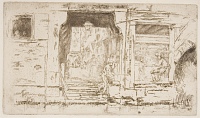Etchings Institutions search term: caxton club
The Fish Shop, Venice | ||
| Number: | 226 | |
| Date: | 1879/1880 | |
| Medium: | etching and drypoint | |
| Size: | 131 x 223 mm | |
| Signed: | butterfly at left and upper left | |
| Inscribed: | no | |
| Set/Publication: | no | |
| No. of States: | 9 | |
| Known impressions: | 18 | |
| Catalogues: | K.218; M.215; W.188 | |
| Impressions taken from this plate (18) | ||
PUBLICATION
EXHIBITIONS
"Whistler is eminently vulgar."—Glasgow Herald. 9
This phrase was cut from an earlier Glasgow Herald review that did not actually refer to this etching, and was not, in fact, entirely uncomplimentary about his etchings. It was extracted from a review of recent etchings by Francis Seymour Haden, Sr (1818-1910), Charles Jacque (1813-1894), Jacques Joseph Tissot (1836-1902), and others, exhibited by C. Silva White at his West George Street Galleries in Glasgow in 1881:
9: London FAS 1883 (cat. no. 6).
10: 'Exhibition of Etchings', Glasgow Herald, 1 June 1881.
11: Liverpool Mercury, 21 February 1883 and 'An Arrangement in White and Yellow', [February 1883], unidentified press-cutting, (GUL PC25/33, 26.
12: 'An Arrangement in White and Yellow', ibid.
 ) and the other major collector of Whistler's etchings at that time, Howard Mansfield (1849-1938), had lent an impression to the exhibition organised by the Caxton Club in Chicago in 1900 (
) and the other major collector of Whistler's etchings at that time, Howard Mansfield (1849-1938), had lent an impression to the exhibition organised by the Caxton Club in Chicago in 1900 ( ). 14
). 14
After Whistler's death no less than four different states were shown in the show organised by the Grolier Club in New York in 1904. Finally Henry Studdy Theobald (1847-1934) lent one impression to the Whistler Memorial Exhibition in London in 1905. 15
13: New York 1903b (cat. nos. 150 a,b,c). See REFERERENCES : EXHIBITIONS.
14: Chicago 1900 (cat. no. 168).
15: New York 1904a (cat. nos. 190a,b,c,d); London Mem. 1905 (cat. no. 188).
SALES & COLLECTORS
 ). and after his death, it was sold at Sotheby's, 3 March 1892 (lot 283), described as a 'touched proof, partly drawn in' and bought by another print dealer, Robert Dunthorne (b. ca 1851) for £3.7.6.
It was acquired by Harry Brisbane Dick (1855-1916) from whom it went to the Metropolitan Museum of Art in 1917 (
). and after his death, it was sold at Sotheby's, 3 March 1892 (lot 283), described as a 'touched proof, partly drawn in' and bought by another print dealer, Robert Dunthorne (b. ca 1851) for £3.7.6.
It was acquired by Harry Brisbane Dick (1855-1916) from whom it went to the Metropolitan Museum of Art in 1917 ( ).
). ), Jules Gerbeau (d. 1906) (
), Jules Gerbeau (d. 1906) ( ), and Samuel Putnam Avery (1822-1904) (
), and Samuel Putnam Avery (1822-1904) ( ).
). ) and later states from Doll & Richards Inc., New York, in 1904 (
) and later states from Doll & Richards Inc., New York, in 1904 ( ) and Thomas Way (1837-1915) in London in 1905 (
) and Thomas Way (1837-1915) in London in 1905 ( ); all of these were bequeathed to the Freer Gallery of Art in 1917.
); all of these were bequeathed to the Freer Gallery of Art in 1917.
